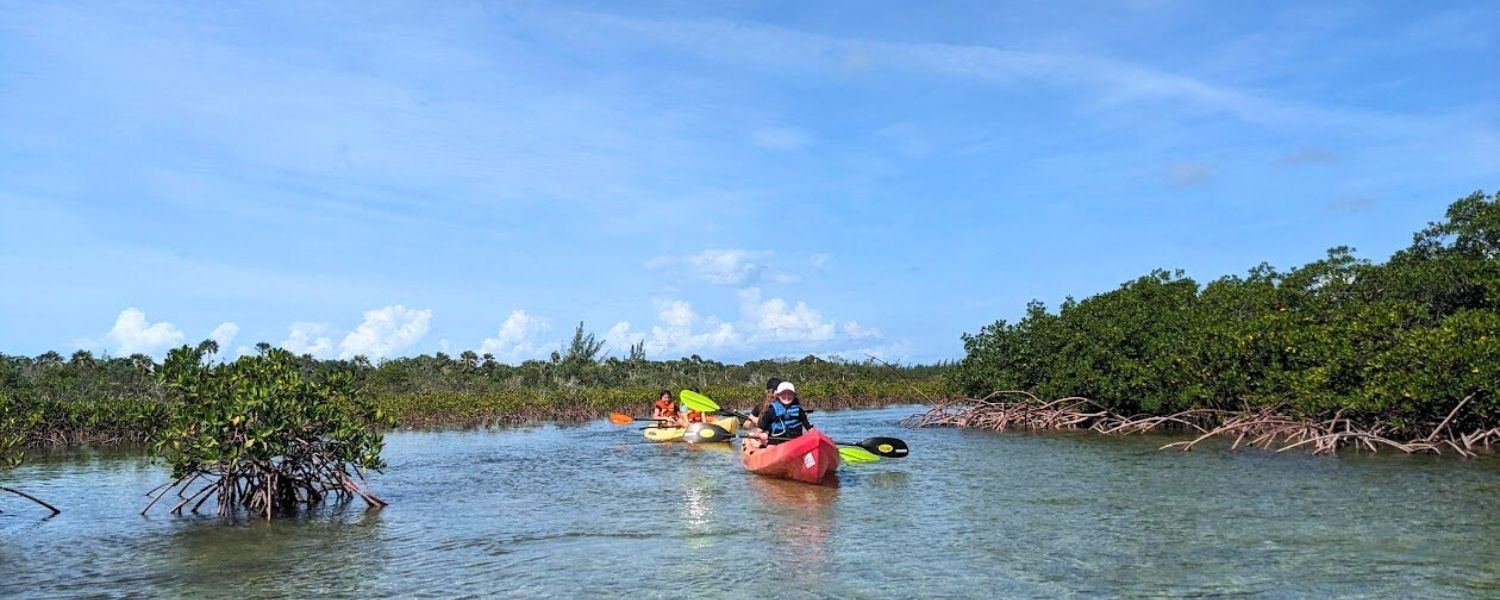
Livin’ on the Edge: How Mangroves Shape and Protect Coastlines
By: Katie Payne, Enrollment Support Coordinator April 22, 2025 Marine Biology
Exploring the Wonders of Mangroves: Nature’s Keystone Engineers
Ever paddled through a maze of tangled roots, where the trees rise from the sea and the water teems with life? Whether you’re kayaking through the calm shallows of the Bahamas, planting baby mangroves in Curaçao, or stepping off the boat into the mangrove-wrapped shores of our Pad in St. Martin, these unique trees are a defining part of the Broadreach experience.
Mangroves might look like just a tangle of roots and branches, but they’re ecological powerhouses—vital to the health of our oceans, coastlines, and climate. Often referred to as keystone species, mangroves support entire ecosystems. Lose them, and everything changes. In this post, we’ll dig into what makes mangroves extraordinary and why our students are helping protect them.
🌿 Mangroves as Carbon Sequestration Champions
One of the most critical roles mangroves play is carbon sequestration. This process captures carbon dioxide (CO₂) and prevents it from entering the atmosphere, where it would otherwise trap heat and contribute to global warming and climate change.
Mangroves help mitigate this by absorbing CO₂ during photosynthesis and storing that carbon in their biomass and the surrounding soil.
Here’s why mangroves are carbon storage superstars:
- 🌿 Store carbon up to 4x more efficiently than tropical rainforests
- 🪵 Lock carbon in trunks, branches, roots, and leaves
- 🧱 Trap and store carbon in deep, oxygen-poor soils for centuries
- 🌍 Help stabilize global temperatures by reducing greenhouse gases
This dual storage method makes mangroves one of the most powerful natural tools in the fight against climate change.
🏝 Stabilizing Coastlines and Preventing Erosion
Mangroves do more than fight climate change—they hold the ground beneath our feet. Their complex root systems stabilize the shoreline, protecting both ecosystems and communities.
Here’s how they defend coastlines:
- 🪨 Prevent erosion by anchoring soil and sediment
- 🧩 Capture sediments from tides and currents, creating new land
- 🌀 Buffer coastal zones against storm surges and flooding
- 🌊 Absorb wave energy and reduce wind damage
- 🏘 Protect infrastructure and ecosystems during extreme weather
With rising sea levels and more intense storms, mangroves are our natural defense line—and they’re more effective (and cheaper) than artificial barriers.
💧 Water Filtration and Pollution Control
Mangroves also act as natural water filters, keeping coastal ecosystems clean and healthy. Their dense root systems work like a living strainer for the water around them.
Here’s how they purify and protect:
- 🌀 Trap sediments and reduce turbidity, allowing sunlight to reach coral and seagrass
- 🌾 Absorb excess nutrients (like nitrogen and phosphorus) from agricultural runoff
- 🧪 Bind heavy metals and toxins in the soil, stopping them from spreading
- 🦠 Support microbes that break down oil, pesticides, and other pollutants
Thanks to these filtration powers, mangroves help keep our oceans cleaner and protect marine habitats from the impacts of human activity.
🐠 Supporting Biodiversity: Nurseries of the Sea
Mangrove forests teem with life and act as nurseries for countless marine species. Their submerged roots provide shelter, food, and protection.
Why mangroves matter to marine life:
- 🐟 Nursery grounds for young fish, crabs, mollusks, and other sea life
- 🐦 Feeding habitats for birds like herons, kingfishers, and migratory species
- 🐊 Support land animals like reptiles, mammals, and insects
- 🔗 Form a crucial link in the coastal food web
By protecting mangroves, we also protect fisheries, bird populations, and biodiversity on land and in the sea.
🧂 Adapting to Saline Conditions: The Role of Sacrificial Leaves
Thanks to unique survival strategies, mangroves are some of the few plants that thrive in saltwater environments.
One of the coolest adaptations? Sacrificial leaves:
- 🌱 These specialized leaves absorb and excrete salt
- ☀️ As salt builds up, the leaves die and fall off, removing salt from the plant
- 🔁 This cycle protects the mangrove from salt damage and allows it to survive in harsh, salty conditions
By mastering these environments, mangroves thrive where most plants would wither—cementing their role as the ultimate ecosystem engineers.
🌎 The Broader Impact of Mangroves
Mangroves don’t just support the environments around them—they help us all.
Their benefits are global:
- 🌿 Climate regulation
- 🛡 Natural disaster protection
- 💧 Water quality improvement
- 🐟 Food security through healthy fisheries
- 🌱 Biodiversity conservation
Yet, mangroves are threatened by deforestation, coastal development, pollution, and rising sea levels. When mangroves disappear, we lose more than trees—we lose entire ecosystems and natural defenses.
Mangroves are an irreplaceable component of tropical and subtropical coastlines; however, despite their resilience, mangroves require protection. By conserving and restoring mangrove forests, we can ensure the continued survival of these keystone species and the ecosystems they support.
💚 Ready to Explore the Edge?
Broadreach students don’t just learn about mangroves—they kayak past them, collect data among them, and even help restore them.
Whether you’re interested in marine biology, climate science, or hands-on conservation, our programs bring you “face-to-root” with the wild world of mangroves.
